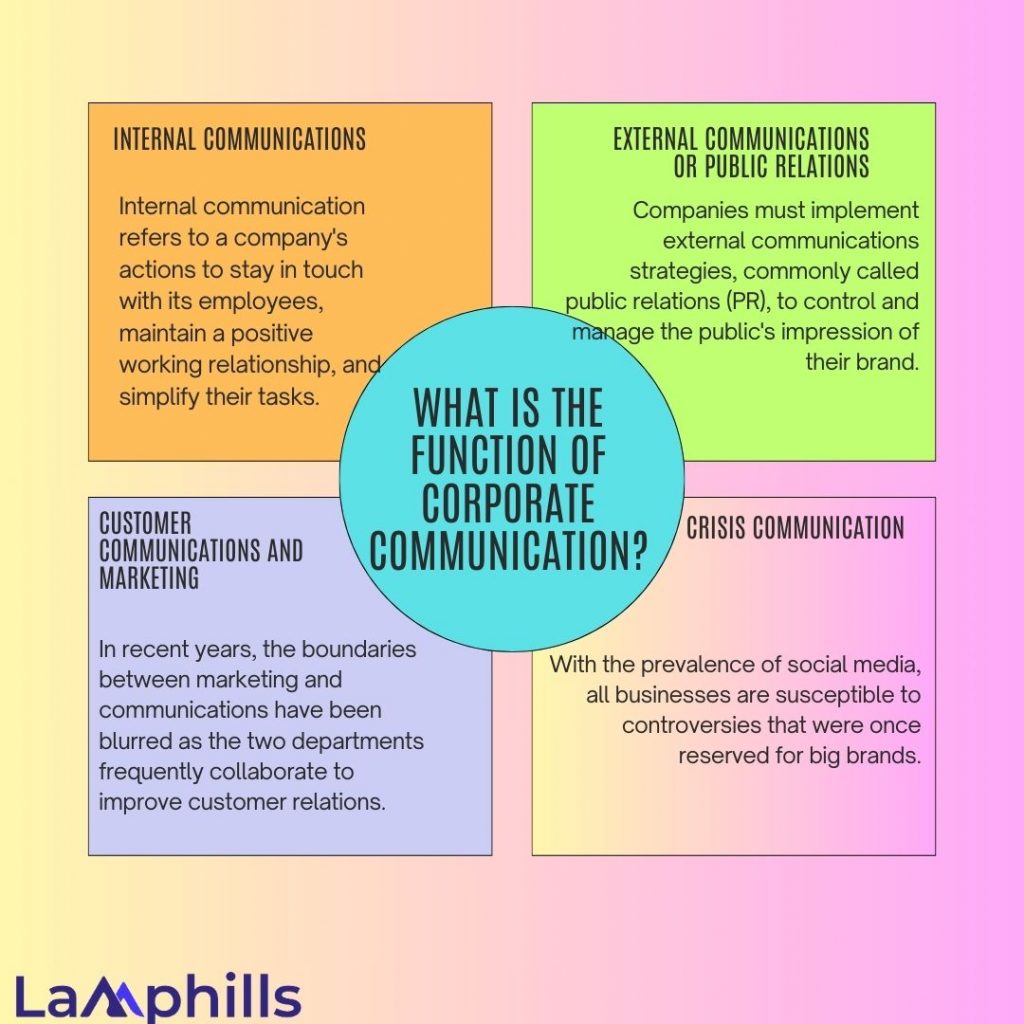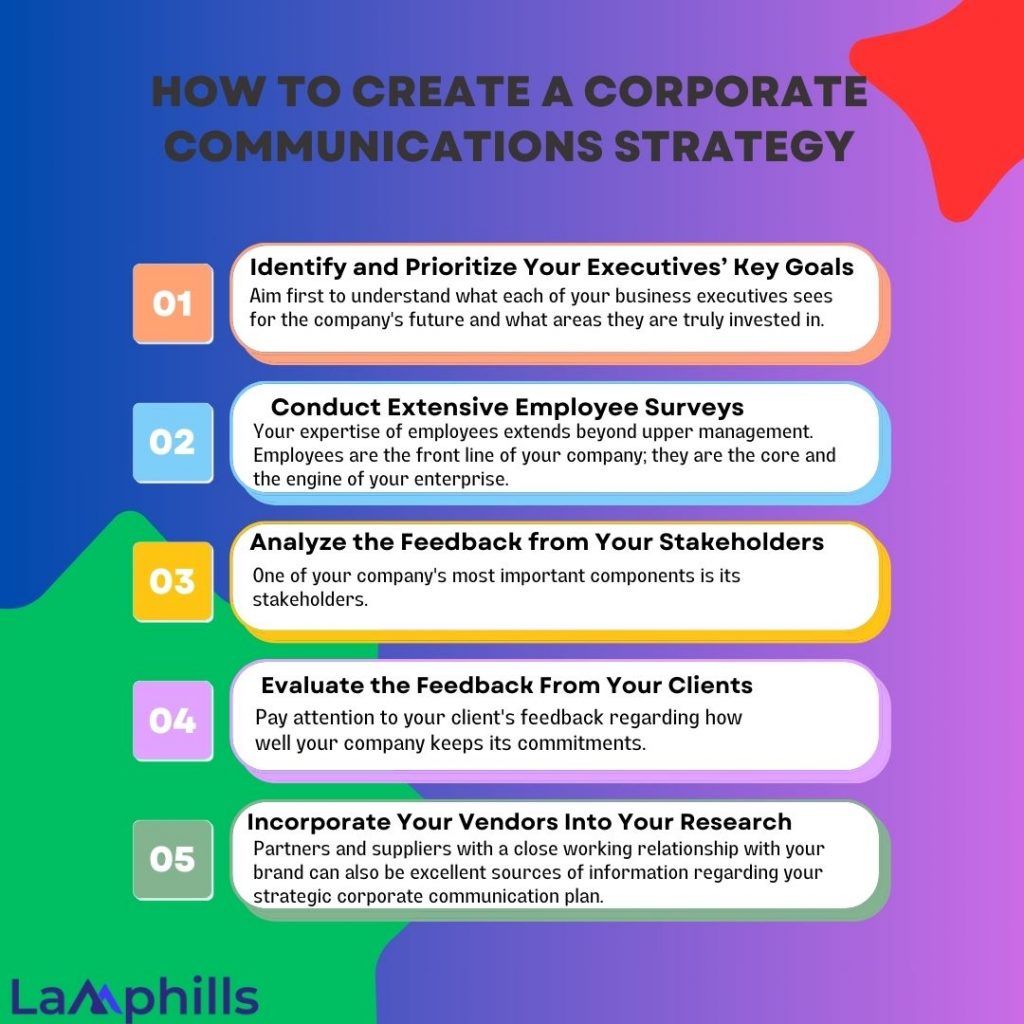It is difficult to overstate the importance of effective communication for most corporate businesses and organizations.
Through effective communication, customers learn about a company’s products or services and what makes brands unique compared to their competitors. Management and staff coordinate their actions to guarantee that the organization is moving toward the same strategic goals. They notify the public, the media, and investors of significant organizational advancements through effective communication.
Most businesses starting with yours, will eventually understand that investing in a corporate communications staff to handle these many tasks is necessary because communication is crucial. In this article, I will explain corporate communications, effective strategies for carrying it out, and who a corporate communication manager is.
Key Point
- Corporate communications is how companies share information with internal and external audiences and engage these audiences to manage brand perception.
- There are three major branches of corporate communications—management communication, marketing communication, and organizational communication—all of which work to develop a strategic approach to an organization’s overall communication.
- Corporate communication functions include internal communications, external communications or public relations, customer communications, marketing, and crisis communication.
- To succeed as a corporate communications manager, you must have specific skills, including public speaking, writing, technical, and research skills.
What is Corporate Communications?
Corporate communications describes companies’ strategies to interact with various internal and external audiences, including stakeholders, customers, employees, media, the general public, and governmental agencies. There are three major branches of corporate communications- management communication, marketing communication, and organizational communication—all of which work to build a strategic approach to an organization’s overall communication. Corporate communications can take several forms and be delivered via a variety of platforms, including:
- Press conferences
- Interviews
- Video
- Photographs
- Advertisements
- Emails
- Press releases
- Meetings
- Reports
Corporate communications typically have a variety of objectives. Many companies try to develop a communications plan that efficiently collaborates with stakeholders, minimizes inconsistencies with the organization’s identity, produces support from both the inside and outside, and promotes a certain brand. When implemented effectively, corporate communications strategies can enhance profitability, customer involvement, and industry longevity. Keeping this objective in mind, companies set up corporate communications departments under the direction of chief executive officers (CEO), who are the main decision-makers when managing the company’s overall strategy.
What Is the Function of Corporate Communication?

Corporate communication functions fluctuate depending on the target audiences and objectives that must be met.
Businesses typically employ specialists for every corporate communication role, including executive, public relations, and internal communications. Nonetheless, various teams frequently have functional overlaps. For example, the team in charge of content development might also manage internal communication campaigns.
This section will examine the corporate communication functions based on their goals and include creative examples from real brands.
#1. Internal Communications
Internal communication refers to a company’s actions to stay in touch with its employees, maintain a positive working relationship, and simplify their tasks.
Effective internal communication is more important than ever as companies transition to hybrid work models.
Employee engagement and internal marketing are the two primary aspects of internal communication. The former aims to improve employee relations, boost productivity, and retain staff, while the latter aims to raise staff members’ understanding of the company’s offerings.
Internal marketing aims to assist employees in developing a sentimental bond with the business’s goods and services. Effective strategies include bulletin boards, company-wide newsletters, and frequent email updates.
Some companies, like QAD Inc., arrange yearly sales launch events to reunite staff members, disseminate best practices and new product information, and realign everyone with the organization’s objectives. Additionally, they honor their best-performing partners and employees.
#2. External Communications or Public Relations
Companies must implement external communications strategies, commonly called public relations (PR), to control and manage the public’s impression of their brand.
PR’s primary purposes are:
- Organize a company’s identity according to its mission and vision.
- Spread the word about new goods and business achievements.
- Share the company’s efforts towards corporate social responsibility.
Because of new technology and a shifting media landscape, PR demands have drastically changed in recent years. Today’s public relations professionals combine old talents with new tools and channels to build consistent narratives that resonate with various audiences.
Here’s an example of an innovative PR campaign that went viral: Rocketlane announced its Series A funding round with a custom rap song.
#3. Customer Communications and Marketing
In recent years, the boundaries between marketing and communications have been blurred as the two departments frequently collaborate to improve customer relations. Corporate communications strategy affects marketing strategy through its external communication teams. Marketing also affects internal communications; both divisions collaborate to accomplish shared objectives. Problems arise when these teams don’t communicate since they can convey rather diverse messages to their separate audiences.
Corporate communication specialists will contribute to developing essential marketing materials for accomplishing their goals while striving to improve customer and other external communication—and if they aren’t already, they should be! The marketing team’s content manager should work with corporate communications to produce marketing collateral, including emails, newsletters, website copy, flyers, social media content, and more.
One notable example of customer communications and marketing comes from the technology giant Apple Inc. Their product launches are renowned for their strategic communication and marketing campaigns.
Before releasing a new iPhone product, for instance, Apple generates anticipation and excitement through various channels. They often send out invitations to a highly anticipated keynote event where they unveil the latest features and innovations. This creates buzz among consumers and the media, sparking conversations and speculation about the upcoming product.
Throughout the launch event, Apple executives effectively communicated the new iPhone model’s benefits and unique selling points, showcasing its advanced technology, sleek design, and user-friendly features. They use captivating visuals, demonstrations, and carefully crafted messaging to engage their audience and build excitement.
#4. Crisis Communication
With the prevalence of social media, all businesses are susceptible to controversies that were once reserved for big brands.
Crisis communication is how you respond to an event that potentially hurts your brand’s reputation or ability to do business. This includes product failures, criticisms, employee errors, site outages, broken links, and responses to global events.
It’s essential to have a strategy in place so that you can take quick action and bring the crisis under control.
Monitoring social media frequently for a potential crisis can be a tedious task. And there’s a risk that it might have already snowballed once your team notices the issue. A social media engagement tool like Hootsuite Social can identify early warning signs of a potential crisis through social listening. You can then quickly take steps to resolve the problem.
Careers in Corporate Communications
The U.S. Bureau of Labor Statistics (BLS) projects a 6% national increase in employment for media and communication occupations between 2021 and 2031, which is anticipated to create roughly 68,600 new jobs.
Public relations professionals are likely to see employment growth of 8% during the same period, according to the BLS. This is quicker than the average for all occupations, with 22,300 new job openings anticipated by 2031.
If you’re considering pursuing a career in corporate communications, here are a few of the roles you might consider:
#1. Corporate Communications Manager
Corporate communications managers perform various tasks to help their organizations communicate effectively with various stakeholder communities, which may involve media relations, investor relations, content creation, and other duties supporting the company’s strategies. This multi-tasking professional’s responsibilities may include:
- Sticking to the company’s editorial style guide and corporate identity standards to ensure compliant, accurate, and error-free content.
- Researching and creating content, such as website copy and articles for the company’s blog, email campaigns, and other external communication platforms.
- Supporting and evaluating the outcomes of communication campaigns.
- Writing news releases and coordinating media events, such as press conferences.
- Working with internal team members to brainstorm content ideas that support the company’s strategy and align with its branding.
#2. Media Relations Coordinator
Media relations coordinators, alternatively referred to as public relations coordinators, perform various functions related to an organization’s public image. Individuals in this role are expected to have strong communication skills as they participate in creating publications, social media posts, videos, and other executions. Typical duties include:
- Analyzing public relations campaigns and reporting to management as to their effectiveness.
- Collaborating with the marketing team to execute campaigns based on strategic initiatives.
- Creating content for marketing executions such as videos, social media posts, newsletters, and brochures.
- Preparing press releases, tracking media coverage, and organizing media events, such as press conferences.
#3. Crisis and Emergency Communications Specialist
While they may require similar education and skills, public relations and crisis communications are different roles with some important differences.
The main goal of a crisis communications specialist is to safeguard the reputation that public relations specialists have worked so hard to cultivate. As previously stated, a crisis could have dire repercussions without a well-thought-out and flawlessly implemented crisis communications plan. In addition to having prior experience in media relations, crisis communications professionals may also need to complete specific training or obtain certification in this field.
The duties of a crisis and emergency communications specialist or crisis manager include:
- Conducting a post-crisis review and making recommendations for strategic improvements.
- Developing and managing the organization’s crisis communications strategies may involve identifying risks and vulnerabilities, collaborating with partners in other corporate departments (such as legal or investor relations), and establishing early monitoring systems.
- Effectively communicating with team members and identifying problems that could impact the execution of the crisis communications strategy.
- Leading the crisis management team, communicating with employees and shareholders, and serving as the organization’s media spokesperson to maintain a positive public image during a crisis response.
#4. Marketing Communications Specialist
Marketing communications specialists wear many hats as they perform various duties related to an organization’s marketing and communications strategies and product promotions. They are frequently called upon to create compelling and innovative content for their organization’s various digital marketing efforts or social media channels. Their duties may include:
- Analyzing consumer data and measuring client satisfaction, conversion rates, and other indicators to assess the success of marketing initiatives.
- Writing and assisting with the development of promotional materials.
- Managing and editing content on the organization’s website.
- Maintaining the company’s social media accounts and posting content to those channels.
Corporate Communications Manager Job Description Template
Lamphills Corporate Communications Manager Job Description Template
What Skills Do Corporate Communications Professionals Need?

To succeed in their positions, corporate communications managers must have many skills. If you’re an organizational leader or a professional in the field looking to assemble a powerful communications team, you should concentrate on honing the following skills:
#1. Public Speaking
Many communications professionals, especially those who work within the public relations section of a corporate communications department, need to possess excellent public speaking skills. Presenting a topic concisely and effectively can make a significant difference in the success of an organization’s public image or ability to secure support from external stakeholders.
#2. Writing Skills
Communications professionals’ primary goal is to engage with specific audiences through channels involving written copy, so they must possess strong writing skills. On a day-to-day basis, a communications professional may need to write emails, memos, blog posts, articles, website copy, social media posts, and other materials. To be effective while performing such duties, communications professionals should focus on honing their writing skills to appeal to diverse audiences across various formats.
#3. Technical Skills
Communication experts must acquire technical competencies like professionals in other fields to perform their jobs well. To achieve their work goals, many people in the communications industry will use a range of technological goods, including chatbots, virtual reality, artificial personal assistants, and others. When communication professionals know how to use these technologies, they can put themselves ahead of the competition and help their organizations reach their goals.
#4. Research Skills
Communications professionals need to develop research skills to search for resources that inform the content they create. This is an especially important competency to develop for external communications professionals who need to write articles, social media content, blog posts, and other information-based content consumed by external players.
Corporate Communications Strategy

A corporate communications strategy is the framework for how a business shares messages internally and externally. It can be considered the roadmap for how a company communicates with its stakeholders, employees, customers, the media, and regulators.
Part of the plan includes what information to share, who the target audience is, how frequently to provide updates, and what channels are the best to relay these messages.
A strategy in place shapes how a company handles communications during crises, changes, campaigns, and new product launches.
What Should a Corporate Communications Strategy Include?
It takes time and consideration to develop an effective corporate communications plan. You’ll want to include details for the objectives, approach, and tracking measures for the goals of your messaging.
You’ll want to include the who, what, when, where, why, and how. Here, I have provided a comprehensive checklist of what a corporate communications strategy should include:
Lamphill Checklist of What a Corporate Communications Strategy Should Include
How to Create a Corporate Communications Strategy
Crafting a corporate communications strategy requires a blend of skill and intuition, a lesson I’ve learned firsthand. A few years ago, I had the honor of working with my corporate communications manager. Together, we took on the difficult task of rebranding our business in the face of changes in the industry. We conducted in-depth market analysis and audience segmentation, identifying important stakeholders and their communication preferences, drawing on our field experience.
We developed a strategic roadmap outlining communication frameworks and channel strategies by utilizing first-hand information from interacting with internal teams and external partners. The strategy’s implementation required adaptability and speed since we had to overcome unforeseen roadblocks and make last-minute adjustments to our plan. We successfully realigned our brand by communicating proactively and using clear language, encouraging stakeholder loyalty and trust.
This process can be broken down as follows to help you construct your core corporate communication strategy:

#1. Identify and Prioritize Your Executives’ Key Goals
Aim to first understand what each of your business executives sees for the company’s future and what areas they are truly invested in. One of the most useful methods to collect this information is to conduct individual interviews with as many top-level management employees as possible. In the interviews, ask them to clearly outline their top priorities for the upcoming year and ensure everyone agrees on what message they want to send to the company.
#2. Conduct Extensive Employee Surveys
Your expertise of employees extends beyond upper management. Employees are the front line of your company; they are the core and the engine of your enterprise. Knowing how your staff views your business and brand is essential to knowing how others view it. This is how brand ambassadors are created. Therefore, you must ensure their opinions are heard while developing your corporate communication strategy. You can determine the most effective communication technique with your team by observing how they react. Use employee surveys to engage people and obtain insightful input about what is and isn’t working.
#3. Analyze the Feedback from Your Stakeholders
One of your company’s most important components is its stakeholders. Therefore, you should promptly modify your communications strategy to address and correct any negative perceptions they may be spreading about your company’s prospects for success. Maintaining success and aligning with long-term goals requires communicating with stakeholders, shareholders, and investors in a way that best serves their interests.
#4. Evaluate the Feedback From Your Clients
Pay attention to your client’s feedback regarding how well your company keeps its commitments. Use the plethora of free online measuring tools to take advantage of social research techniques and understand how to initiate discussions that will lead to favorable mentions of your company among customers and future customers.
#5. Incorporate Your Vendors Into Your Research
Partners and suppliers with a close working relationship with your brand can also be excellent sources of information regarding your strategic corporate communication plan. Ideally, your partners and suppliers strongly believe joining you will benefit their business. If so, note what they say they value most about working for your organization. Use that input to improve your business communication strategy and give your partner connections more structure.
What Is the Difference Between Marketing and Corporate Communications?
The major differences between corporate and marketing communications lie in the audience each type of communication is intended to target and the particular entity each message is intended to represent. Corporate communication represents a singular entity’s uniform opinions, strategies, and motivations. Communication is designed uniquely to influence customers to purchase the goods and services the corporate entity produces.
Corporate and marketing communications should not be confused with other corporate communications channels, particularly public and community relations. Public relations is broadly defined as a corporate body’s attempt to influence their organization’s perception in the general public’s eyes. Community relations represent the interaction of a corporate entity or institution with the citizens who live and work in and around its place of business.
Is Corporate Communications the Same as PR?
No. The key difference between public relations and corporate communications is that corporate communication is focused on communications within an organization. Public relations is only focused on communications with the public.
Is Corporate Communications a Good Career?
Yes, corporate communications is a rewarding and good career, but it can also be demanding and stressful.
Bottom Line
Those looking to break into many entry-level communications positions at most companies can typically do so by earning a bachelor’s degree in communications, marketing, or a related field. However, to qualify for more competitive managerial and senior-level positions, candidates must be capable of demonstrating a certain level of skill and expertise beyond what an undergraduate degree typically signifies.
Earning an advanced degree, such as a Master of Science in Corporate and Organizational Communication, can help you obtain this skill level to advance into senior-level positions.
Related Articles
- Stakeholder Engagement: How to Plan an Effective Engagement Strategy
- STAKEHOLDER THEORY: Definition, Benefits, and Challenges






